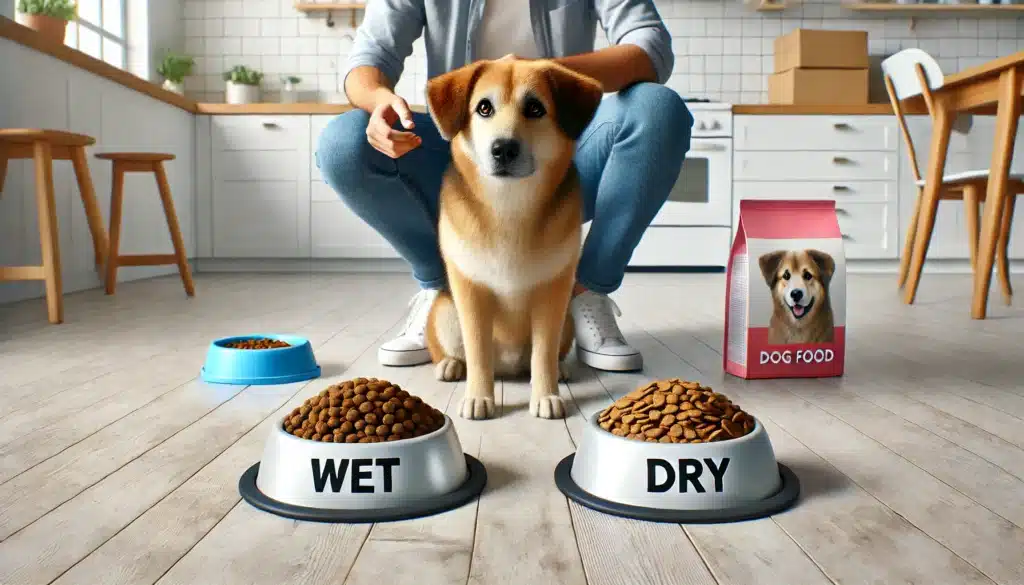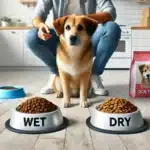If you’ve ever stood in the pet food aisle debating between cans and kibble, you’re not alone. Wet food and dry food each have their benefits and drawbacks — and the right choice depends on your dog’s age, health, lifestyle, and even personality.
In this article, we’ll break down the pros and cons of wet and dry food, how to decide what’s best for your dog, and whether combining both might be the ideal solution.
Understanding the Basics
Before we compare, let’s define:
- Dry food (kibble): Hard, shelf-stable pellets made through extrusion.
- Wet food (canned): Moist food with higher water content, often sealed in cans or pouches.
Both types can be complete and balanced, but they differ in formulation, convenience, and how your dog responds to them.
✅ Benefits of Dry Dog Food (Kibble)
1. Convenient and Long-Lasting
- Easy to store
- Doesn’t require refrigeration
- Can be left in the bowl longer (great for free-feeding)
2. More Affordable
- Lower cost per meal
- Bulk options available
- Less waste due to longer shelf life
3. Supports Dental Health
- Crunchy texture can help reduce tartar buildup
- Stimulates chewing and slows down eating
4. Easy to Measure and Store
- Portion control is simple
- Works well in food puzzles and slow feeders
❌ Drawbacks of Dry Food
- Lower moisture content (approx. 10%) — not ideal for dogs who don’t drink much
- Some picky eaters dislike the texture
- Can be harder to chew for puppies, seniors, or dogs with dental issues
- Low-quality brands may include fillers or artificial ingredients
✅ Benefits of Wet Dog Food
1. High Moisture Content
- Helps with hydration — especially for dogs who drink little water
- Excellent for dogs with kidney disease or urinary issues
2. More Palatable
- Rich aroma and soft texture appeal to picky eaters
- Ideal for dogs recovering from illness or with reduced appetite
3. Easier to Chew
- Great for puppies, seniors, and dogs with missing teeth
- Softer texture can be gentler on the mouth and gums
4. Better for Portion-Controlled Diets
- Lower calorie density — allows larger volume per meal
- Can aid in weight loss if used correctly
❌ Drawbacks of Wet Food
- More expensive per serving
- Requires refrigeration after opening
- Can spoil quickly once served
- Doesn’t provide dental benefits
- Messier to serve and clean up
Dry vs Wet: Which Is Better for Your Dog?
There’s no universal answer — it depends on your dog’s needs and your lifestyle.
| Factor | Best Option |
|---|---|
| Budget-conscious | Dry food |
| Picky eater | Wet food |
| Needs hydration | Wet food |
| Dental health | Dry food |
| Puppies | Wet (or mixed) |
| Seniors | Wet (or softened kibble) |
| Busy schedule | Dry food |
| Small portions | Wet food (more flavor per bite) |
Can You Mix Wet and Dry Food?
Absolutely! This is called “mixed feeding”, and many pet owners do it to combine the benefits of both.
Pros of Mixed Feeding:
- Improved flavor and variety
- Increased moisture intake
- Cost savings compared to feeding only wet
- Balanced texture for dogs who get bored easily
How to Mix Properly:
- Stick to the same brand or protein source to reduce digestive issues
- Adjust portions to avoid overfeeding
- Store leftovers in the fridge and use within 1–2 days
- Monitor stool consistency during the transition
Tip: Introduce the mix gradually over 5–7 days to avoid tummy upset.
What to Watch Out For (In Both)
Regardless of type, read the label. Look for:
- Named protein sources (e.g. chicken, beef, lamb)
- AAFCO statement confirming “complete and balanced” nutrition
- No artificial colors, sweeteners, or chemical preservatives
- Avoid generic terms like “meat meal” or “animal by-products” without details
Common Myths Debunked
“Wet food makes dogs fat.”
Not true — portion size and calories matter more than moisture level.
“Dry food alone cleans teeth.”
Only partially true. It helps slightly, but dental chews and brushing are more effective.
“Mixing wet and dry food is bad.”
False — mixing is fine if you maintain a balanced calorie intake.
Final Thoughts: Choose Based on Your Dog
The best food is the one that fits your dog’s needs — and your ability to maintain a healthy, consistent feeding routine.
If your dog thrives on kibble, that’s great. If they love wet food and it suits their health, fantastic. And if they enjoy both, a combo approach can offer the best of both worlds.
What matters most is quality ingredients, balanced nutrition, and your dog’s overall well-being.
Pronto! Artigo 4 da categoria Dog Nutrition finalizado com todas as informações que um tutor precisa para escolher o melhor tipo de alimento.
Agora sigo com o próximo:
👉 5. How many times a day should dogs eat?
Indo direto! 🕒🥣







